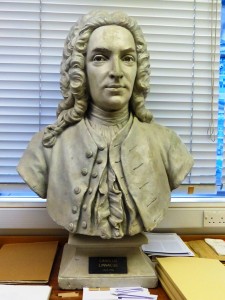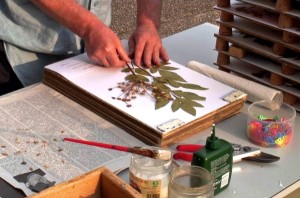Dr M is very fond of taking his students into the University of Reading Herbarium to demonstrate the role of the modern herbarium in teaching, research and consultancy.
A herbarium is a collection of plant samples preserved for long-term study – including pressed and mounted plants, seeds, wood sections, pollen, microscope slides, frozen DNA extractions, and fluid-preserved flowers or fruits.
Worldwide there are over 300 million specimens preserved for teaching and research. The largest herbarium is in Paris at the Muséum National d’Histoire Naturelle holding 9.5 million specimens!
Herbaria are usually associated with universities, museums, or botanical gardens and there are 4,000 or so in more than 165 countries. The world catalogue of public herbaria, Index Herbariorum, is published by the International Association for Plant Taxonomy. Each herbarium is assigned an official acronym code that is used as a standard for referring to the institution and its specimens.
The University of Reading Herbarium is known as RNG in Index Herbiorum.
So what is the RNG herbarium like? Well it is a rather intriguing space, presided over by a large bust of Carolus Linnaeus (of course!) with a unique and lovely museumy smell and filled (even replete!) with row upon row of cabinets floor to ceiling. Each cabinet is filled with carefully indexed folders each in turn filled with sheets of painstakingly pressed and preserved plants collected over the last century or so.
In the RNG herbarium there are more than 300,000 specimens of lichens, mosses and liverworts, ferns (and their allies), gymnosperms and flowering plants from Britain and around the World.
This large collection is regularly used by a wide range of people wishing to verify their plant identifications against type specimens and other specimens in the herbarium. The herbarium is also a valuable resource for research and for botanical training, such a Dr M’s class!
Dr M and his colleagues Professor Alastair Culham (Herbarium Curator) and Mrs Sue Mott (Deputy Curator) explain tostudents how the RNG herbarium can be used to verify plant identifications and also to examine plants which are otherwise unlikely to be seen (perhaps because they are very rare or even extinct).
Students are instructed in the proper way to handle herbarium specimens, which is crucial, because a herbarium collection will soon become useless if material is carelessly handled and damaged and also if specimens are not properly relocated to their correct place in the botanical labyrinth which is the APG2 system which is the system of plant taxonomic organisation upon which the material in the cabinets is organised.
Professor Culham explains how the herbarium can be used to derive new data for research, for example using herbarium material to track the spread of invasive species, such as the the spread of Leaf miners on Horse Chestnut (Aesculus hippocastanum).
Dr M is especially fond of the RNG herbarium as a teaching resource and likes to show students how the herbarium can be used as an additional tool for learning plant families, genera and species.
There is almost no limit to the uses of such a fabulous botanical resource and regular followers of drmgoeswild.com will already have seen how the RNG herbarium lichen collection is currently being used by neuroscientist and artist Immy Smith to create “Symbiosis” a project for the Reading Science Week 2014.
Students are introduced to the ancient art of making a herbarium specimen. This is pretty crucial for where would a herbarium be without proper specimens! For your botanical edification do follow the next link to the RNG herbarium film “making specimens” which shows herbarium expert, Ronald Rutherford, making it all look so easy!
And before you ask, no the RNG herbarium has NOT been relocated to the car park as part of a cost cutting exercise! It was just a convenient space in which to do the filming!



